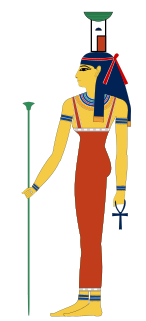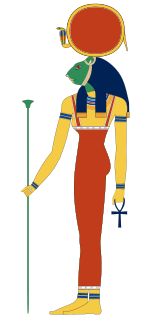
Nephthys or Nebthet or Nebet-Het is a goddess in ancient Egyptian religion. A member of the Great Ennead of Heliopolis in Egyptian mythology, she was a daughter of Nut and Geb. Nephthys was typically paired with her sister Isis in funerary rites because of their role as protectors of the mummy and the god Osiris and as the sister-wife of Set.
The Elephantine Papyri consist of 175 documents from the Egyptian border fortresses of Elephantine and Aswan, which yielded hundreds of papyri in Hieratic and Demotic Egyptian, Aramaic, Koine Greek, Latin and Coptic, spanning a period of 1000 years. The documents include letters and legal contracts from family and other archives, and are thus an invaluable source of knowledge for scholars of varied disciplines such as epistolography, law, society, religion, language and onomastics. They are a collection of ancient Jewish manuscripts dating from the 5th century BCE. They come from a Jewish community at Elephantine, then called ꜣbw. The dry soil of Upper Egypt preserved documents from the Egyptian border fortresses of Elephantine and Aswan.

Seti II was the fifth pharaoh of the Nineteenth Dynasty of Egypt and reigned from c. 1200 BC to 1194 BC. His throne name, Userkheperure Setepenre, means "Powerful are the manifestations of Re, the chosen one of Re." He was the son of Merneptah and Isetnofret II and sat on the throne during a period known for dynastic intrigue and short reigns, and his rule was no different. Seti II had to deal with many serious plots, most significantly the accession of a rival king named Amenmesse, possibly a half brother, who seized control over Thebes and Nubia in Upper Egypt during his second to fourth regnal years.
The Eighth Dynasty of ancient Egypt is a poorly known and short-lived line of pharaohs reigning in rapid succession in the early 22nd century BC, likely with their seat of power in Memphis. The Eighth Dynasty held sway at a time referred to as the very end of the Old Kingdom or the beginning of the First Intermediate Period. The power of the pharaohs was waning while that of the provincial governors, known as nomarchs, was very important, the Egyptian state having by then effectively turned into a feudal system. In spite of close relations between the Memphite kings and powerful nomarchs, notably in Coptos, the Eighth Dynasty was eventually overthrown by the nomarchs of Heracleopolis Magna, who founded the Ninth Dynasty. The Eighth Dynasty is sometimes combined with the preceding Seventh Dynasty, owing to the lack of archeological evidence for the latter which may be fictitious.

Amenmesse was the fifth pharaoh of the Nineteenth Dynasty in Ancient Egypt, possibly the son of Merneptah and Queen Takhat. Others consider him to be one of the innumerable sons of Ramesses II. Very little is known about this pharaoh, who ruled Egypt for only three to four years. Various Egyptologists date his reign between 1202 BC–1199 BC or 1203 BC–1200 BC with others giving an accession date of 1200 BC. Amenmesse means "born of or fashioned by Amun" in Egyptian. Additionally, his nomen can be found with the epithet Heqa-waset, which means "Ruler of Thebes". His royal name was Menmire Setepenre.

Maya was an important figure during the reign of Pharaohs Tutankhamun, Ay and Horemheb of the eighteenth dynasty of Ancient Egypt. Maya's titles include: fan bearer on the King's right hand, overseer of the treasury, chief of the works in the necropolis, and leader of the festival of Amun in Karnak.

The Turin Papyrus Map is an ancient Egyptian map, generally considered the oldest surviving map of topographical interest from the ancient world. It is drawn on a papyrus reportedly discovered at Deir el-Medina in Thebes, collected by Bernardino Drovetti in Egypt sometime before 1824 AD and now preserved in Turin's Museo Egizio. The map was drawn about 1150 BC by the well-known Scribe-of-the-Tomb Amennakhte, son of Ipuy. It was prepared for Ramesses IV's quarrying expedition to the Wadi Hammamat in the Eastern Desert, which exposes Precambrian rocks of the Arabian-Nubian Shield. The purpose of the expedition was to obtain blocks of bekhen-stone to be used for statues of the king.

Gebel el-Silsila or Gebel Silsileh is 65 km north of Aswan in Upper Egypt, where the cliffs on both sides close to the narrowest point along the length of the entire Nile. The location is between Edfu in the north towards Lower Egypt and Kom Ombo in the south towards Upper Egypt. The name Kheny means "The Place of Rowing". It was used as a major quarry site on both sides of the Nile from at least the 18th Dynasty to Greco-Roman times. Silsila is famous for its New Kingdom stelai and cenotaphs.

Ankhu was an Egyptian vizier who lived in the 13th Dynasty around 1750 BC.
The Mayer Papyri are two Ancient Egyptian documents from the Twentieth Dynasty that contain records of court proceedings.
The Instructions of Kagemni is an ancient Egyptian instructional text of wisdom literature which belongs to the sebayt ('teaching') genre. Although the earliest evidence of its compilation dates to the Middle Kingdom of Egypt, its authorship has traditionally yet dubiously been attributed to Kagemni, a vizier who served during the reign of the Pharaoh Sneferu (r. 2613–2589 BC), founder of the fourth dynasty of Egypt.
Isetnofret(3s.t-nfr.t; also spelled as Isetneferet, Isisnofret etc.) was an ancient Egyptian female name, meaning “Isis is beautiful”.
The Papyrus Boulaq 18 is an Ancient Egyptian document found in 1860 AD in the tomb of the scribe of the great enclosure Neferhotep. It is now in the Egyptian Museum in Cairo.

Isetnofret was one of the Great Royal Wives of Pharaoh Merenptah.

Hori was a Vizier of Ancient Egypt. He served during the reign of pharaohs Sethi II, Siptah, Tawosret, Setnakhte and Ramesses III.
Khaemtir was a Viceroy of Kush and Vizier of Ancient Egypt. He served during the reign of Amenmesse and Sethi II.
Panehesy was a Vizier of Ancient Egypt. He served during the reign of Merenptah during the 19th Dynasty.
The Papyrus Salt 124 is an ancient Egyptian papyrus dating to the beginning of the 20th Dynasty. This papyrus is a copy of a letter addressed to the vizier of the time, most likely Hori.
Articles related to ancient Egypt include:

The Cavern deities of the underworld were ancient Egyptian minor deities charged with punishing the damned souls by beheading and devouring them.














